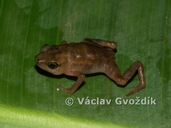|
Didynamipus sjostedti Andersson, 1903
Four-digit Toad | family: Bufonidae genus: Didynamipus |
| Species Description: Andersson, L. G. (1903). Neue Batrachier aus Kamerun, von den Herren Dr. Y. Sjöstedt und Dr. R. Jungner gesammelt. Verhandlungen des Zoologisch-Botanischen Vereins in Wien 53: 141–145. | |
 © 2006 Vaclav Gvozdik (1 of 2) |
|
|
|
Description DESCRIPTION: Didynamipus sjostedti is a toad with a snout-vent length of 15 - 18 mm. The triangular head is broad, flat, and has a width of 4.8 - 5.8 mm. The snout length is 2.7 - 3.0 mm, which is as long as the eye diameter. The nostrils are below the canthus rostralis, and they are slightly closer to the snout tip than they are to the eye. The canthus rostralis is prominent. The interorbital space is much wider than the eyelid. The forearm is 4.0 - 4.3 mm. The finger formula is I < IV < II < III. The tibia is 6.8 - 7.8 mm, and is longer than the thigh, which is 6.2 - 7.0 mm. The foot length is 4.6 - 5.0 mm. The toe formula is I < II or V < III < IV. No subarticular protuberances are present, but the metatarsal tubercle is rounded. The tibiotarsal articulation reaches the eye. The skin is covered in fine granulations, and a triangular area below the vent is covered in flat warts (Andersson 1903).DIAGNOSIS: (How this species is differentiated from similar species) COLORATION: (In life and/or in preservative) The dorsum is yellowish brown with small, dark spots. The ventrum is whitish. There is a black stripe extending from the eye to the snout tip, below the canthus rostralis. It is unclear whether this is in life or preservative (Andersson 1903). VARIATION: (if known) Distribution and Habitat Country distribution from AmphibiaWeb's database: Cameroon, Equatorial Guinea, Nigeria
Life History, Abundance, Activity, and Special Behaviors Larva Trends and Threats Possible reasons for amphibian decline General habitat alteration and loss Comments PHYLOGENETIC RELATIONSHIPS: The species is the only member of its genus, based on morphology (Grandison 1981).ETYMOLOGY (Origin or explanation of scientific name): The species epithet “sjostedti” is in honor of Bror Yngve Sjöstedt, a Swedish naturalist who collected the type specimen (Andersson 1903). OTHER INTERESTING INFORMATION: Didynamipus sjostedti was once considered the rarest bufonid in Africa. This was in part due to the lack of sampling in the region, and observations have since shown that the species has a larger range than initially believed (Gonwouo 2013). References Gonwouo, Ndeh, A., Tapondjou, W., & Noonan, B. (2013). Amphibia, Bufonidae, Didynamipus sjostedti Andersson, 1903: new records and a review of geographic distribution. Check List (9, Issue 4, 780–782). [link] Grandison, A.G. (1981). Mophology and Phylogenetic Position of the West African Didynamipus Sjostedti Andersson, 1903 (Anura Bufonidae). Monitore Zoologico Italiano - Italian Journal of Zoology, 15, 187-215. IUCN SSC Amphibian Specialist Group. 2017. Didynamipus sjostedti. The IUCN Red List of Threatened Species 2017: e.T54811A16272990. [link] Accessed on 18 April 2023. Originally submitted by: Madeline Ahn (2023-04-26) Description by: Madeline Ahn (updated 2023-04-26)
Distribution by: Madeline Ahn (updated 2023-04-26)
Life history by: Madeline Ahn (updated 2023-04-26)
Larva by: Madeline Ahn (updated 2023-04-26)
Trends and threats by: Madeline Ahn (updated 2023-04-26)
Comments by: Madeline Ahn (updated 2023-04-26)
Edited by: Ann T. Chang (2023-04-26) Species Account Citation: AmphibiaWeb 2023 Didynamipus sjostedti: Four-digit Toad <https://amphibiaweb.org/species/332> University of California, Berkeley, CA, USA. Accessed Jun 6, 2025.
Feedback or comments about this page.
Citation: AmphibiaWeb. 2025. <https://amphibiaweb.org> University of California, Berkeley, CA, USA. Accessed 6 Jun 2025. AmphibiaWeb's policy on data use. |


 Map of Life
Map of Life